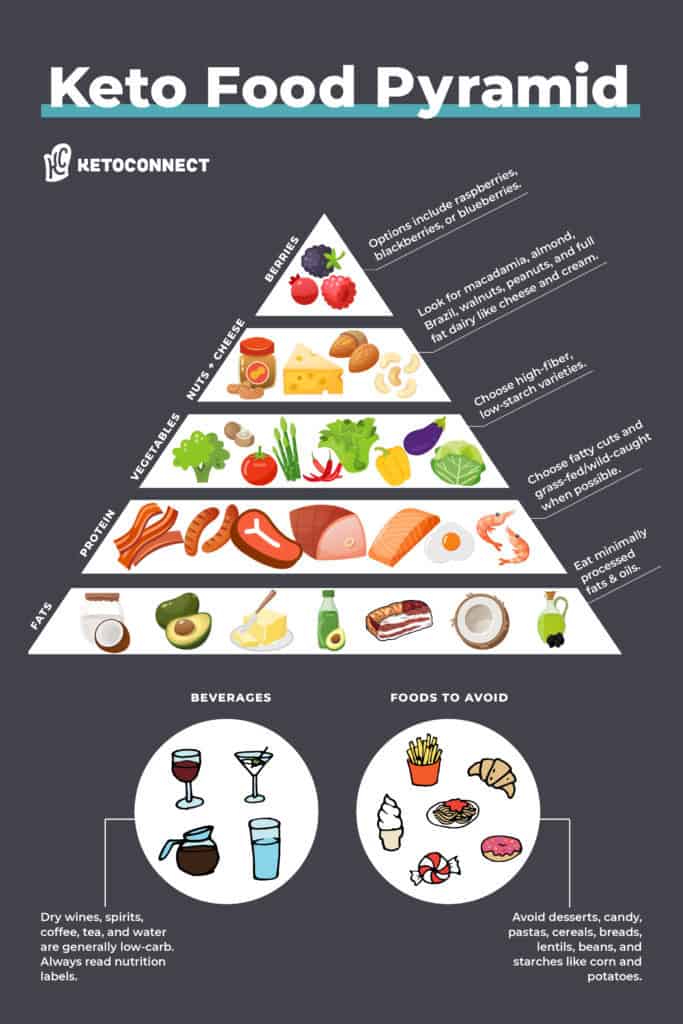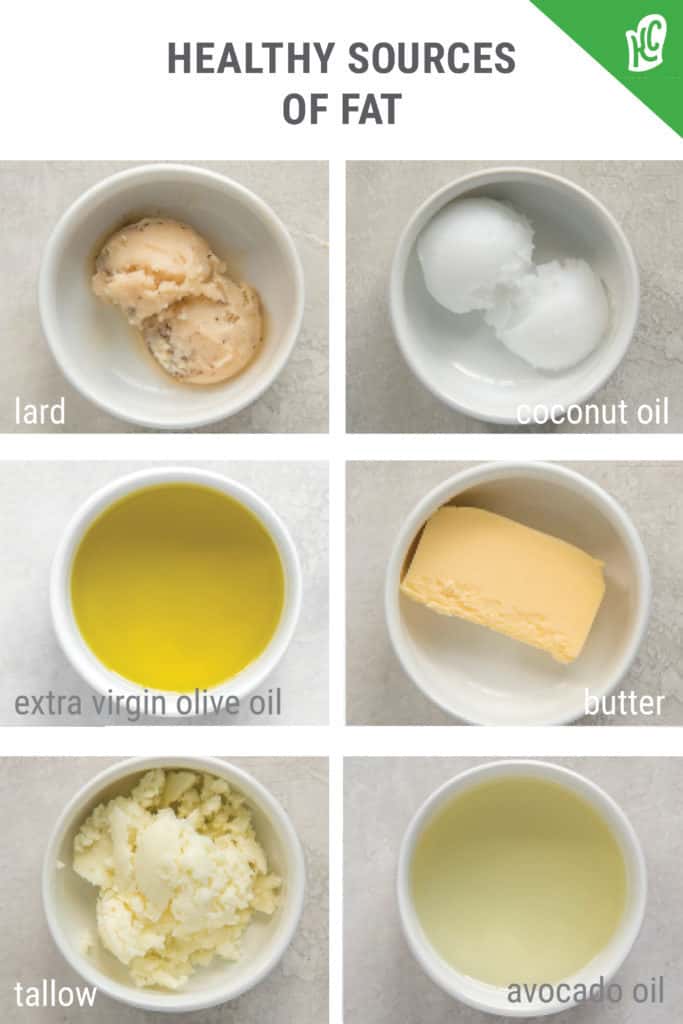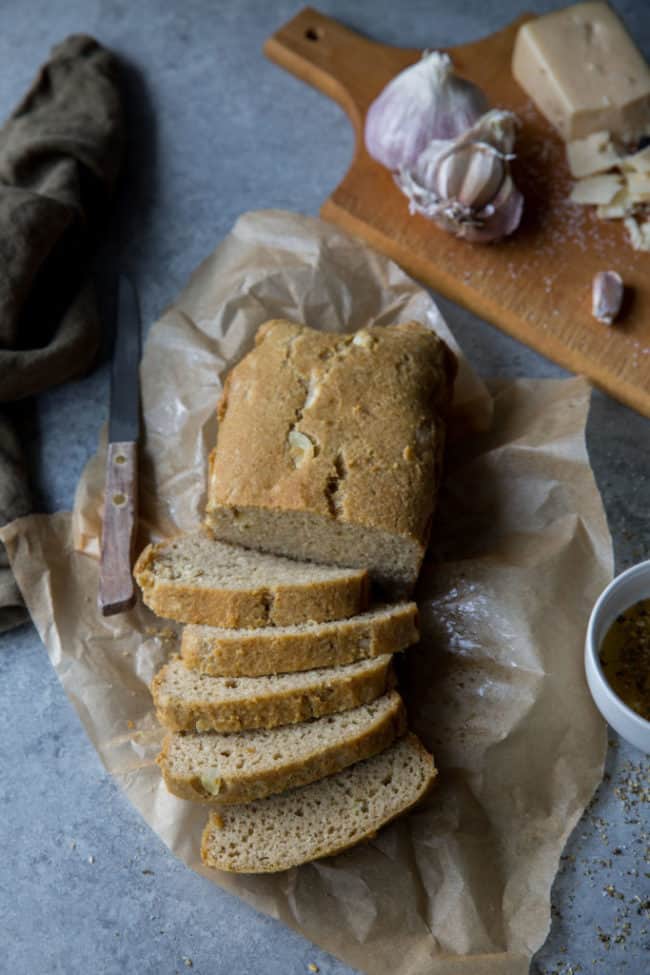Do you remember that food pyramid a lot of us were taught in elementary school? Not only has the government done away with the traditional food pyramid, but there is now a healthier alternative: the keto food pyramid.

If you’re on a high-fat, low-carb meal plan like the ketogenic diet (AKA keto), this keto food pyramid is a must. It’s easy to understand, and it’s vital to keeping true to your low carb lifestyle.
Stick to this pyramid as you create your weekly keto grocery list, and your body will thank you.
Our Keto Diet Food Pyramid
This keto food pyramid is designed to get your body into a state of ketosis (and stay there).
Ketosis occurs when your body doesn’t have enough carbohydrates (sugar) to produce energy, so it instead turns to fat burning for energy. These fat cells are used to create ketones, which many scientists agree are more efficient energy sources than carbs.
What are the food groups on the keto food pyramid?
When adhering to a keto diet, there are low-carb food choices you should gravitate towards:
- Healthy fats
- Fatty proteins
- Non-starchy vegetables
- Certain cheeses, nuts, and seeds
- A little bit of fruit
However, this keto diet food pyramid also clarifies foods to avoid:
- Sugar
- Bread
- Pasta
- Vegetable oils
Healthy Fats and Oils
Most important to the keto food pyramid are healthy fats and oils. Around half of your calories should consist of these high-quality fats.
What are healthy fats? Well, the word “fat” can be a scary word. But that’s just because of the hard work of the sugar industry from the past seventy years. Fats are necessary to your body’s proper function. Low-fat diets are less efficient for weight loss, compared to low carb diets. Plus, a ketogenic diet supports heart health significantly better than low-fat options.
Also, look for fats that derive from animals, like butter and tallow. These incredibly nutrient-dense foods get a bad rep from misleading “science” about the dangers of saturated fats, but they’re great for feeling full and getting plenty of important nutrients in addition to good macro balance.
Plus, animal fats are the richest sources of heart-healthy vitamin K2, which many people are deficient in.
These are some of the best fat sources, when you’re on a keto diet:
- Ghee
- Grass-fed butter
- Tallow
- Lard
- Bone marrow or bone broth
- Extra virgin olive oil
- Cod liver oil
- Coconut oil
- Avocado oil
- Sesame oil
- MCT oil

You may notice several keto-friendly oils on this list. Whether you cook in these oils or use them as an ingredient, the above oils are your best friends.
Steer clear of vegetable oils. Despite their healthy-sounding name, vegetable oils have been linked with inflammation. This affects everything from your immune system to your heart health.
Fatty Proteins
Fatty proteins are important to the keto food pyramid and the body’s nutritional needs. Proteins are macronutrients, the building blocks of our bones, muscles, skin, and blood.
But there’s this common misconception — probably the most common among new keto dieters. Many try to get their bodies into a state of ketosis with the same amount of protein as fat — fifty-fifty. Unfortunately, it’s pretty hard to get into ketosis with that ratio. Keto is very importantly a moderate-protein, not a high-protein, diet.
How much protein should you eat in a meal while on keto? Aim for 25 percent protein with 75 percent fat. A typical keto meal includes about four or five ounces of protein.
Fatty fish, seafood, fattier chicken cuts, and eggs have moderate protein content while balancing with plenty of fat:
- Salmon
- Catfish
- Cod
- Shellfish
- Oysters and clams
- Eggs
- Chicken (thighs, wings, or legs)
Fish are also rich in omega-3 fatty acids, which come with their own health benefits, like improved heart and mental health.
There are also fatty cuts of red meat that you should regularly add to your meals:
- Veal
- Steak
- Lamb
- Pork
- Salami and pepperoni
Just like with your healthy fats, it’s important to know where your proteins are sourced from. Grass-fed beef and wild caught fish are two examples of quality sourced meats. On the other hand, salami and pepperoni are technically keto-friendly but carry some risks as ultra-processed foods.
Although you can tweak your macros to include lean meats, like chicken and turkey, without dropping out of ketosis, we’ve found that avoiding these is usually simpler. Super lean meats with high protein levels but no fat are more difficult to work into a normal keto diet meal plan. If you eat keto, swap breasts out with thighs, wings, or legs.
Click here for a printer friendly version of this graphic!
Non-Starchy Vegetables
Vegetables are rich in nutrients. They are important to every person’s overall health. We definitely want to keep non-starchy vegetables on our plate when we’re on the keto diet when we can, although different peoples’ need for vegetables may be higher or lower than the next person.
But many vegetables are not low-carb vegetables. Starchy veggies like potatoes, corn, and carrots are relatively high in carbohydrates. We instead look to the low-carb vegetables.
You may have heard avocados touted as a “superfood” in the past. Well, this is where the avocado’s magic powers are strongest.
Avocado is a tasty vegetable (sometimes considered a fruit) that is very low on carbs — mainly because it’s so high in fiber, and you have to subtract fiber from carbs to get your “net carbs”. Avocados also come with a host of unique benefits: healthy heart, healthy brain, and preventing diabetes.
What are the best vegetables to eat when on keto?
- Avocados (a staple of most keto diets!)
- Leafy greens, like spinach and kale
- Bell peppers
- Tomatoes
- Cauliflower
- Broccoli
- Asparagus
- Zucchini
- Eggplant
- Garlic
- Cayenne
- Celery
Don’t rely too heavily on vegetables. But a small portion of non-starchy veggies at every meal is ideal for low carb diets like keto.
Cheeses, Nuts, and Seeds
Another group of foods to have a little bit of every day is cheeses, nuts, and seeds. An odd pairing, yes, but these three foods have two things in common:
- Cheeses, nuts, and seeds can all serve as keto-friendly snacks throughout the day.
- Cheeses, nuts, and seeds should not be eaten in high quantities, but small amounts here and there are perfectly acceptable.
Unlike milk, cheese is low-carb and high in fat. Unprocessed cheeses like cheddar, mozzarella, cream, goat, and bleu are often best for digestion.
When looking for keto-friendly dairy products, make sure it’s full-fat dairy with close to zero carbs. Beyond cheeses, think about adding full-fat sour cream or Greek yogurt to your keto diet.
Should you go nuts for nuts? Yes!
Can I plant a seed in your mind about seeds? “Pro-seed,” I imagine you are saying. (See what we did there?)
Like most snacks, make sure you consume small portions. One or two ounces of these nuts and seeds should act as a great snack:
- Pecans
- Macadamia nuts
- Walnuts
- Hazelnuts
- Almonds
- Pistachios
- Cashews
- Peanuts
- Pili nuts (some of our favorites — these are 0-carb and super high in fat!)
- Brazil nuts
- Flaxseeds
- Chia seeds
- Hemp seeds
- Sunflower seeds
- Sesame seeds
Keto Friendly Fruits
You may think fruits have too much sugar to be keto friendly. Yes, fruits have natural sugars and can be slightly addictive. However, a few lower-carb fruits shouldn’t push you over your daily carb limit. And their health benefits are too good to pass up.
Here are some other fruits that have less than 10 grams of net carbs in a one-cup serving:
- Lemons
- Limes
- Blackberries
- Raspberries
- Strawberries
- Coconuts
Fruits are the smallest part of the keto food pyramid. If you’re not careful, fruits can kick you out of ketosis. Eating fruits can spike your blood sugar, and they don’t make you feel full for very long.
Fruits are filled with micronutrients. Nature has crafted fruits into something that we really want to eat. But make sure you keep fruits to a minimum when you’re on a low carb diet.
What to Drink on Keto
You need to stay hydrated! But with all these restrictions, what can you drink while on keto?
Water. Every day. Water is your new best friend. Find a good deal on a reusable BPA-free water bottle and keep it filled each day.
Although water is the absolute best liquid for anyone to drink — whether on keto or not — there are some other low carb drinks you can look for (some of which are great fat sources):
- Bulletproof (butter) coffee
- Sparkling water
- Tea
- Coffee
- Dry wines
- Hard liquors (in moderation)
- Bone broth
- Non-dairy milk alternatives
Obviously, all of these drinks must be unsweetened to qualify as low carb.
The best teas to drink are turmeric tea and green tea. Green tea is a potent antioxidant that may promote heart health. Black tea is also great for keeping macros in check and boosting your caffeine intake for the day (it’s what is served at most restaurants).
A popular variation on coffee among keto dieters is something called bulletproof coffee. Simply put, this means you add ghee (or butter) to your coffee, often paired with MCT oil.
When looking for non-dairy milk alternatives, check the net carbs. For instance, sweetened and unsweetened almond milk are right next to each other on the shelf, and only one of them is good for a low-carb diet plan.
High Carb and Other Foods to Avoid
Now that you have the keto food pyramid at your fingertip, its helpful to look at a list of “don’ts” when it comes to the keto diet.
Obviously, we’re avoiding carbs here. So here are some food choices that are high in sugars or carbohydrates in general:
- Bread
- Pasta
- Added sugar (refined or raw)
- Honey
- Pizza
- Fries
- Beans
- Rice
- Condiments high in sugar
- Higher carb fruits, such as apples or bananas
- Starchy vegetables like corn, potatoes, and carrots
- Hot dogs, hoagies, and hamburgers (because of the buns)
As far as drinks are concerned, do not drink sugary beverages, including sodas and sugary alcoholic drinks. Also avoid fruit juices and milk because of their sugar content.
Technically speaking, diet sodas are low carb. However, avoid them like the plague. Actually, the artificial sweeteners in diet sodas can have a few downsides in common with the plague.
In Summary
- The keto food pyramid offers an easy-to-understand visual of what to eat and what to avoid when you’re trying to maintain a state of ketosis.
- Focus on healthy fats, proteins, non-starchy vegetables, cheeses, nuts, and seeds.
- Avoid sugary foods and drinks, bread, pasta, milk, and fried foods.
Sources
- Paoli, A., Bosco, G., Camporesi, E. M., & Mangar, D. (2015). Ketosis, ketogenic diet and food intake control: a complex relationship. Frontiers in psychology, 6, 27. Full text: https://www.frontiersin.org/articles/10.3389/fpsyg.2015.00027/full
- Puchalska, P., & Crawford, P. A. (2017). Multi-dimensional roles of ketone bodies in fuel metabolism, signaling, and therapeutics. Cell metabolism, 25(2), 262-284. Full text: https://www.ncbi.nlm.nih.gov/pmc/articles/PMC5313038/
- Yancy, W. S., Olsen, M. K., Guyton, J. R., Bakst, R. P., & Westman, E. C. (2004). A low-carbohydrate, ketogenic diet versus a low-fat diet to treat obesity and hyperlipidemia: a randomized, controlled trial. Annals of internal medicine, 140(10), 769-777. Full text: https://www.ncbi.nlm.nih.gov/pubmed/15148063
- Cranenburg, E. C., Schurgers, L. J., & Vermeer, C. (2007). Vitamin K: the coagulation vitamin that became omnipotent. Thrombosis and haemostasis, 98(07), 120-125. Abstract: https://www.ncbi.nlm.nih.gov/pubmed/17598002
- Tan, P., Dong, X., Mai, K., Xu, W., & Ai, Q. (2016). Vegetable oil induced inflammatory response by altering TLR-NF-κB signalling, macrophages infiltration and polarization in adipose tissue of large yellow croaker (Larimichthys crocea). Fish & shellfish immunology, 59, 398-405. Full text: https://www.ncbi.nlm.nih.gov/pubmed/27818336
- Harris, W. S., Miller, M., Tighe, A. P., Davidson, M. H., & Schaefer, E. J. (2008). Omega-3 fatty acids and coronary heart disease risk: clinical and mechanistic perspectives. Atherosclerosis, 197(1), 12-24. Full text: https://www.ncbi.nlm.nih.gov/pubmed/18160071
- Swanson, D., Block, R., & Mousa, S. A. (2012). Omega-3 fatty acids EPA and DHA: health benefits throughout life. Advances in nutrition, 3(1), 1-7. Full text: https://www.ncbi.nlm.nih.gov/pmc/articles/PMC3262608/
- Yahia, E. M., García-Solís, P., & Celis, M. E. M. (2019). Contribution of fruits and vegetables to human nutrition and health. In Postharvest physiology and biochemistry of fruits and vegetables (pp. 19-45). Woodhead Publishing. Full text: https://www.sciencedirect.com/science/article/pii/B9780128132784000026
- Li, Y., Zhang, J. J., Xu, D. P., Zhou, T., Zhou, Y., Li, S., & Li, H. B. (2016). Bioactivities and health benefits of wild fruits. International journal of molecular sciences, 17(8), 1258. Full text: https://www.ncbi.nlm.nih.gov/pmc/articles/PMC5000656/
- Mahmassani, H. A., Avendano, E. E., Raman, G., & Johnson, E. J. (2018). Avocado consumption and risk factors for heart disease: a systematic review and meta-analysis. The American journal of clinical nutrition, 107(4), 523-536. Full text: https://www.ncbi.nlm.nih.gov/pubmed/29635493
- Scott, T., Rasmussen, H., Chen, O., & Johnson, E. (2017). Avocado consumption increases macular pigment density in older adults: A randomized, controlled trial. Nutrients, 9(9), 919. Full text: https://www.ncbi.nlm.nih.gov/pmc/articles/PMC5622679/
- Lerman-Garber, I., Ichazo-Cerro, S., Zamora-González, J., Cardoso-Saldaña, G., & Posadas-Romero, C. (1994). Effect of a high-monounsaturated fat diet enriched with avocado in NIDDM patients. Diabetes care, 17(4), 311-315. Full text: https://www.ncbi.nlm.nih.gov/pubmed/8026287
- Ahmed, S. H., Guillem, K., & Vandaele, Y. (2013). Sugar addiction: pushing the drug-sugar analogy to the limit. Current Opinion in Clinical Nutrition & Metabolic Care, 16(4), 434-439. Full text: https://www.ncbi.nlm.nih.gov/pubmed/23719144
- Talsness, C. E., Andrade, A. J., Kuriyama, S. N., Taylor, J. A., & Vom Saal, F. S. (2009). Components of plastic: experimental studies in animals and relevance for human health. Philosophical Transactions of the Royal Society B: Biological Sciences, 364(1526), 2079-2096. Full text: https://royalsocietypublishing.org/doi/abs/10.1098/rstb.2008.0281
- Zhou, F., Jongberg, S., Zhao, M., Sun, W., & Skibsted, L. H. (2019). Antioxidant efficiency and mechanisms of Green tea, Rosemary or Maté extracts in porcine Longissimus dorsi subjected to iron-induced oxidative stress. Food Chemistry, 125030. Full text: https://www.sciencedirect.com/science/article/pii/S030881461931132X
- Quan, J., Jia, Z., Lv, T., Zhang, L., Liu, L., Pan, B., … & Tian, J. (2019). Green tea extract catechin improves cardiac function in pediatric cardiomyopathy patients with diastolic dysfunction. Journal of biomedical science, 26(1), 32. Full text: https://www.ncbi.nlm.nih.gov/pmc/articles/PMC6505250/
- Crichton, G., Alkerwi, A., & Elias, M. (2015). Diet soft drink consumption is associated with the metabolic syndrome: a two sample comparison. Nutrients, 7(5), 3569-3586. Full text: https://www.ncbi.nlm.nih.gov/pmc/articles/PMC4446768/
- Wersching, H., Gardener, H., & Sacco, R. L. (2017). Sugar-sweetened and artificially sweetened beverages in relation to stroke and dementia: are soft drinks hard on the brain?. Full text: https://www.ncbi.nlm.nih.gov/pmc/articles/PMC5468791/
Written by
Matt Gaedke
Matt is a former college basketball player turned computer engineer who discovered his passion for health and nutrition after cutting sugar from his diet in 2016. That year he founded KetoConnect with Megha in order to share their ketogenic lifestyle through recipes, videos, and educational content. Matt is always seeking to grow and try new things, a passion he shares with his wife and two amazing sons.

